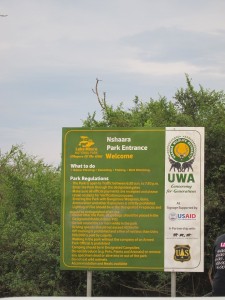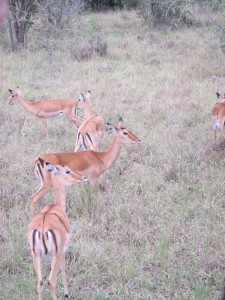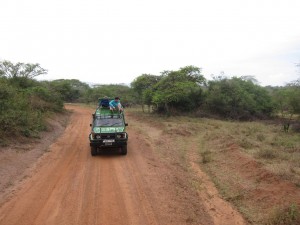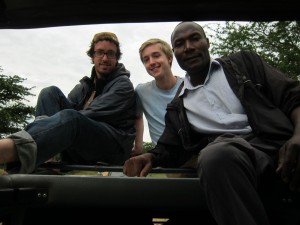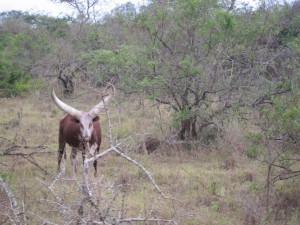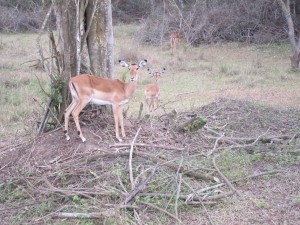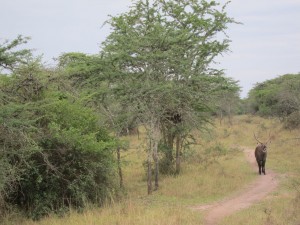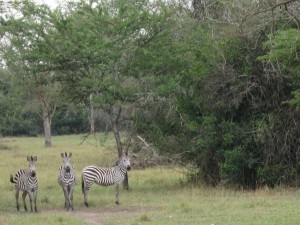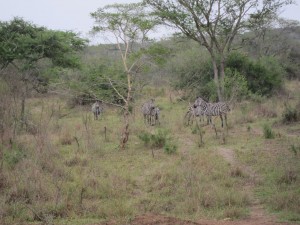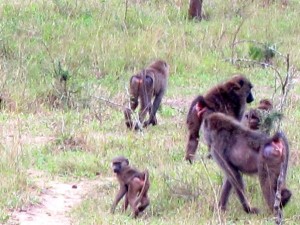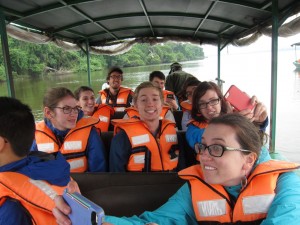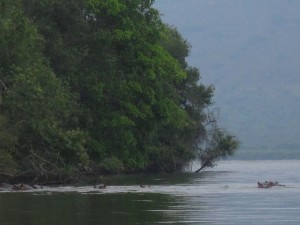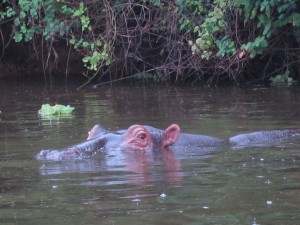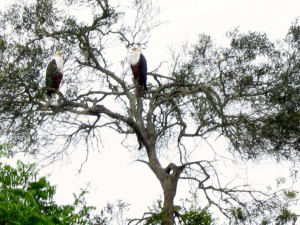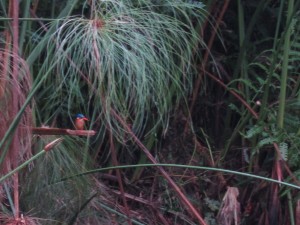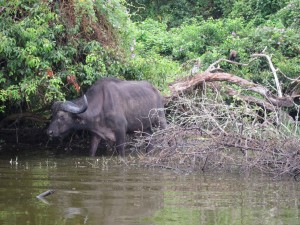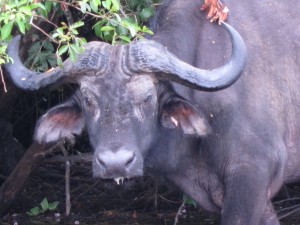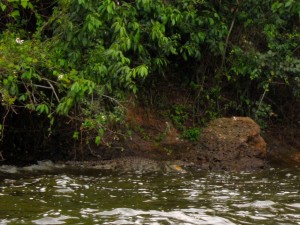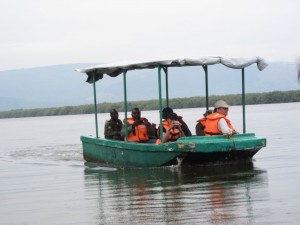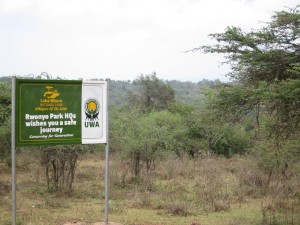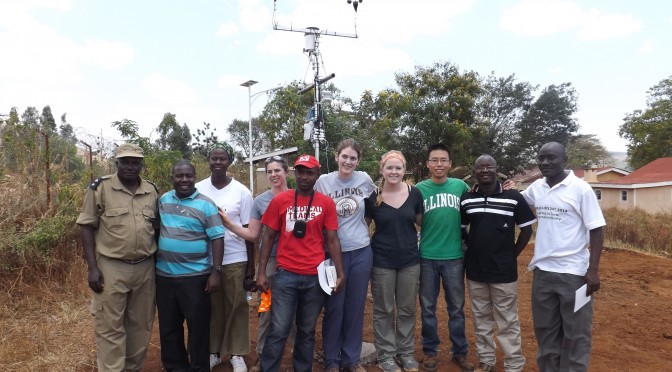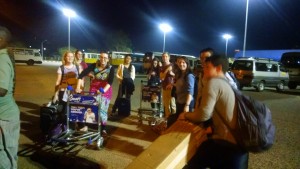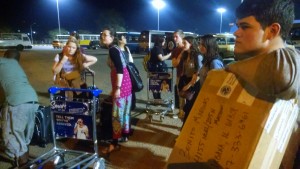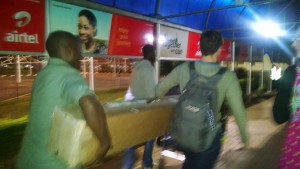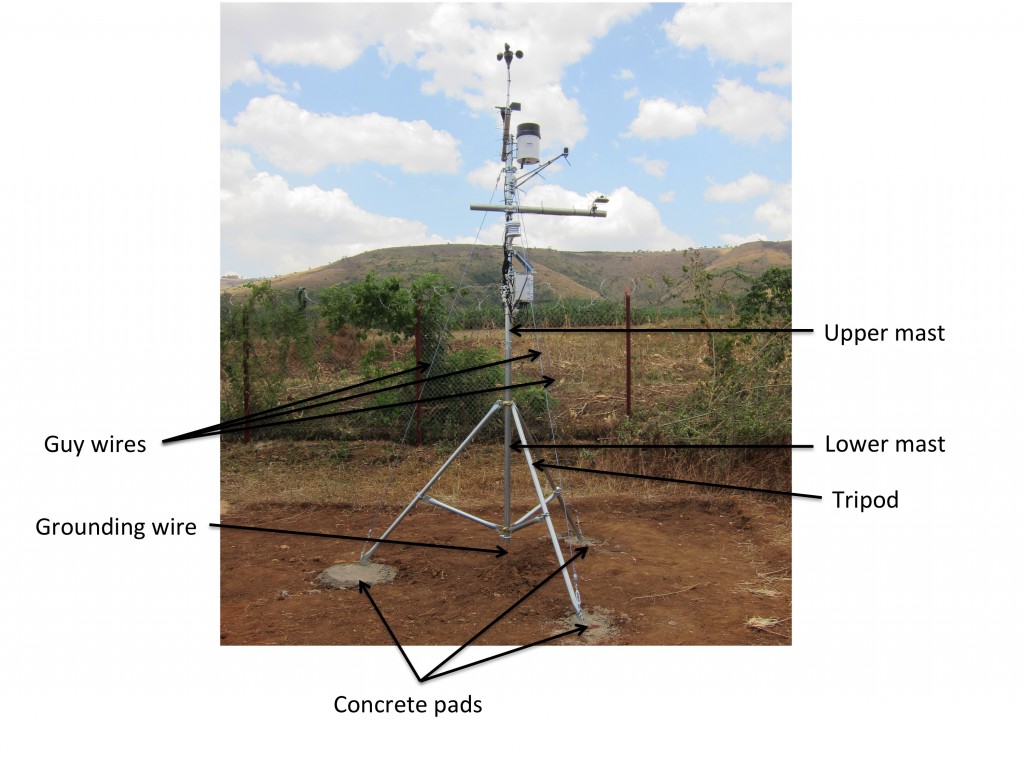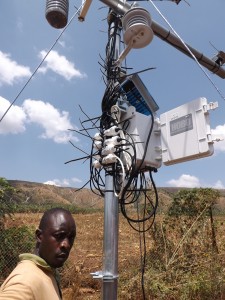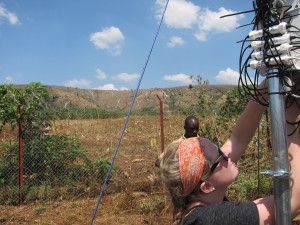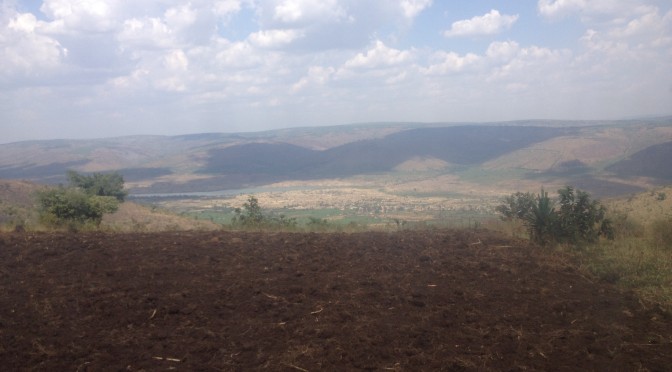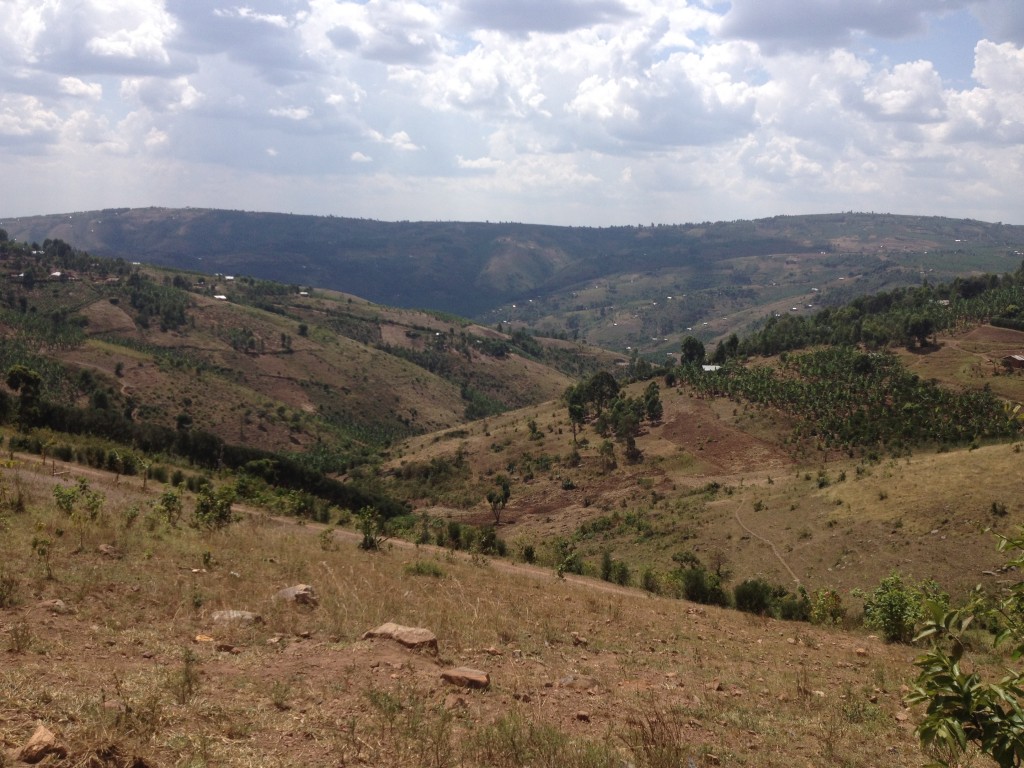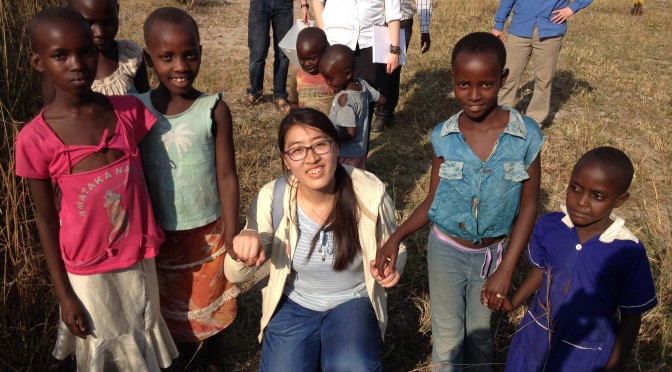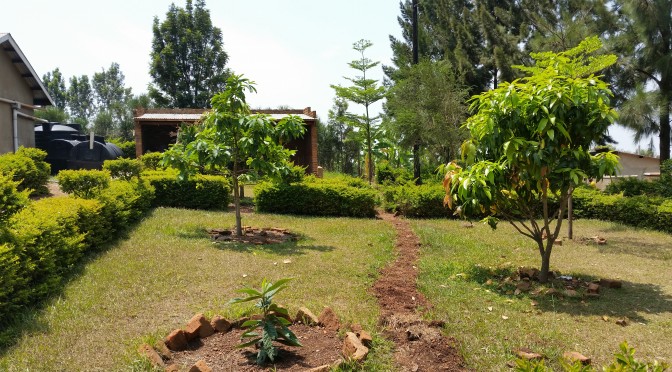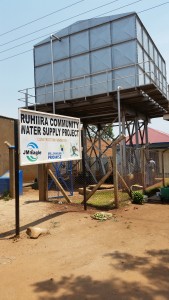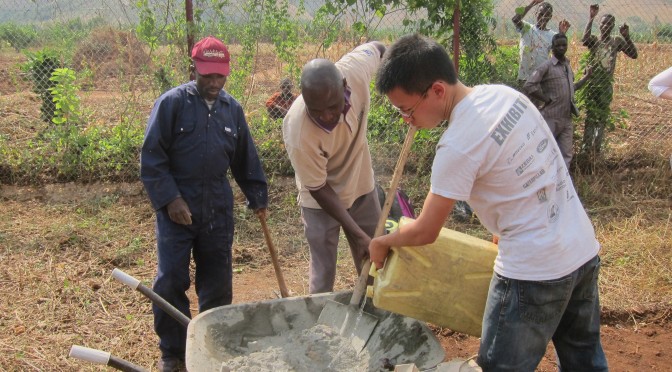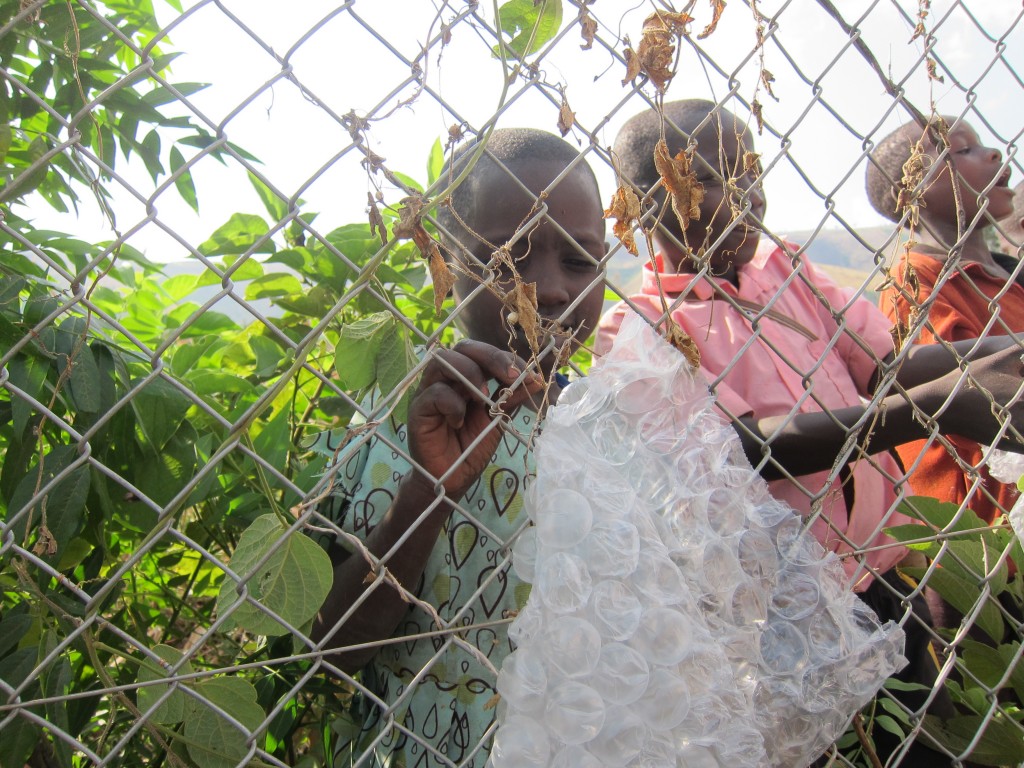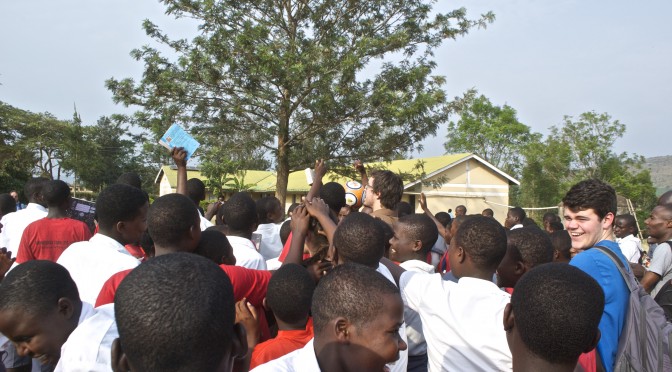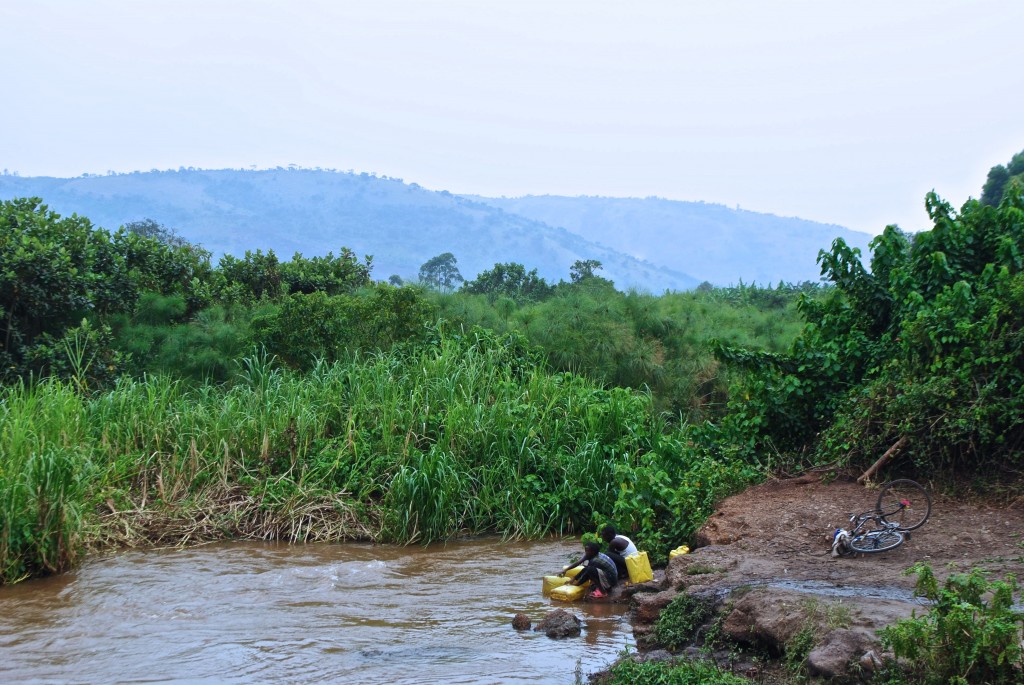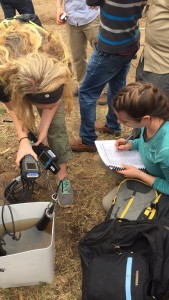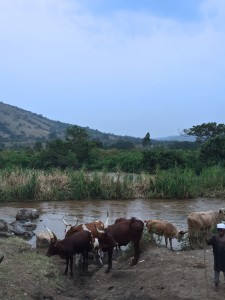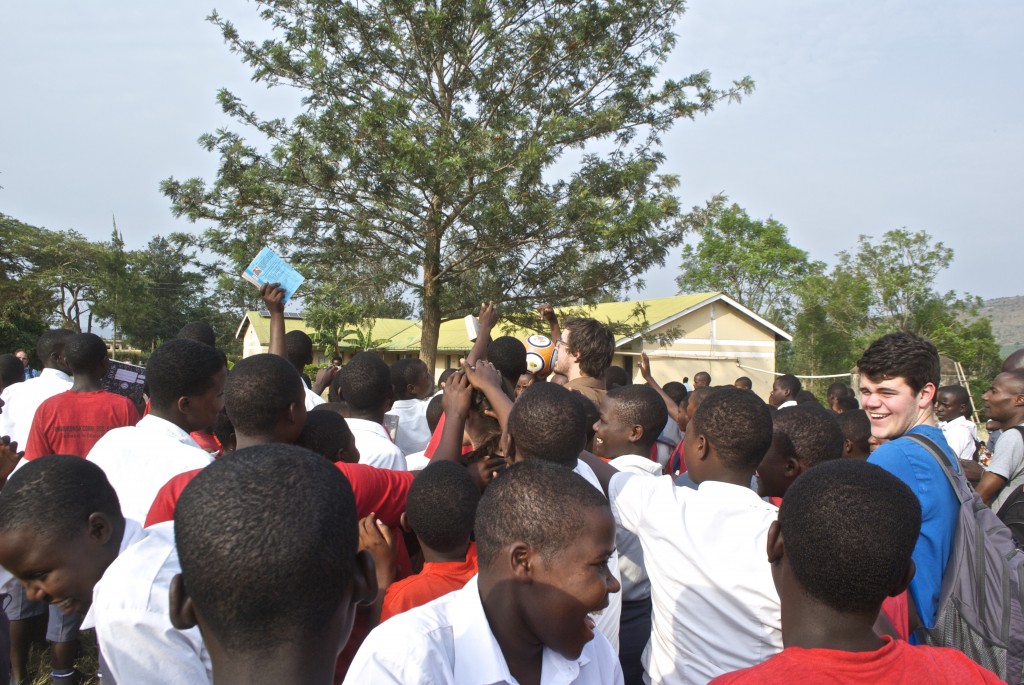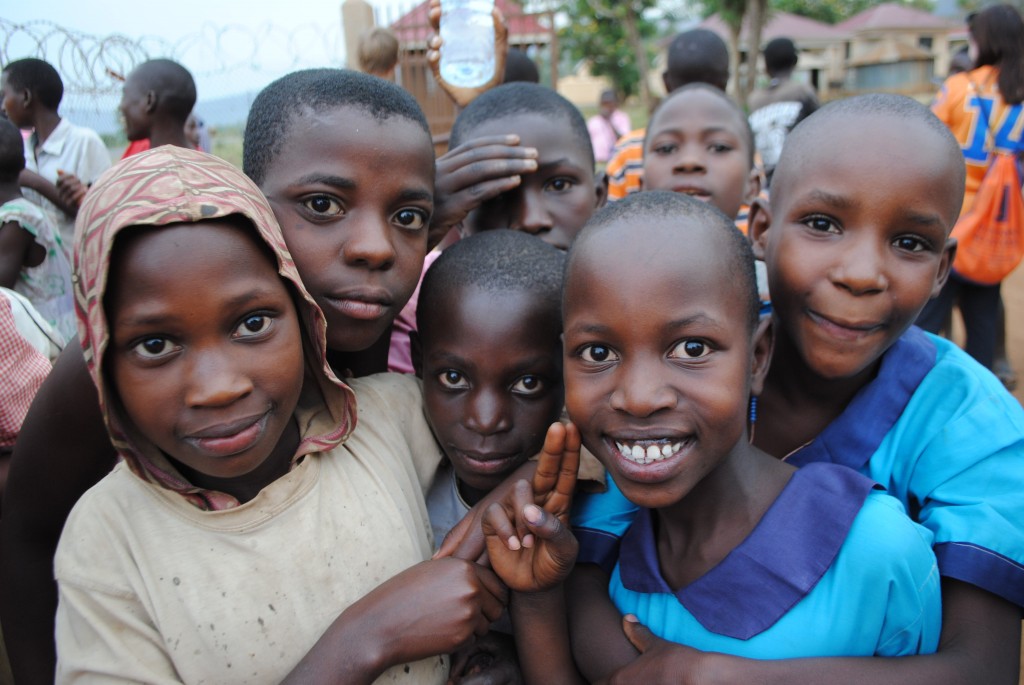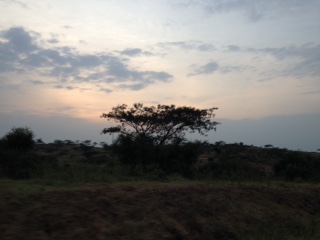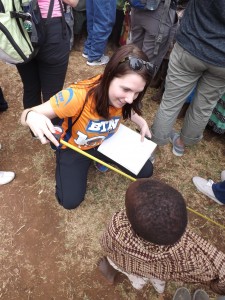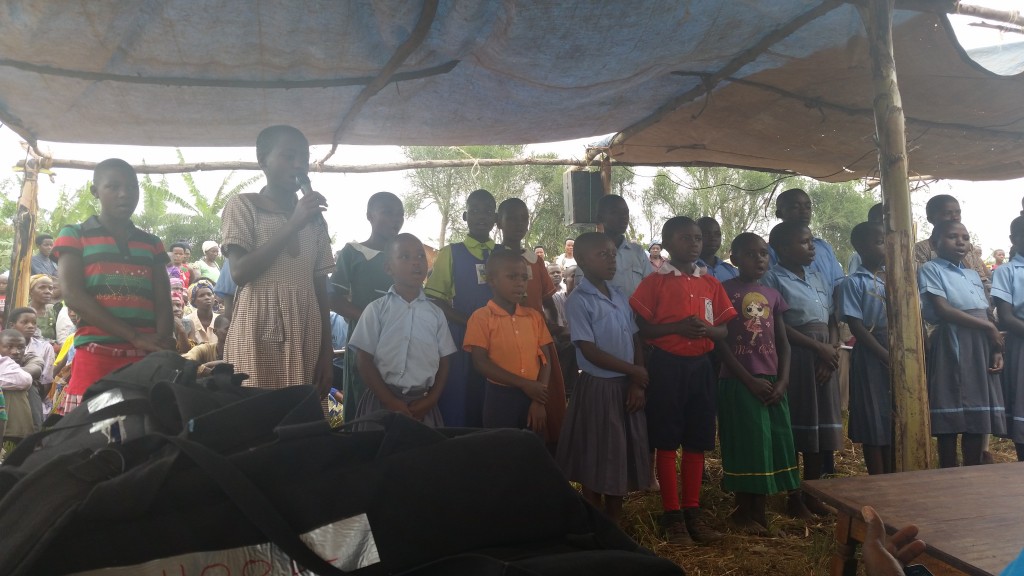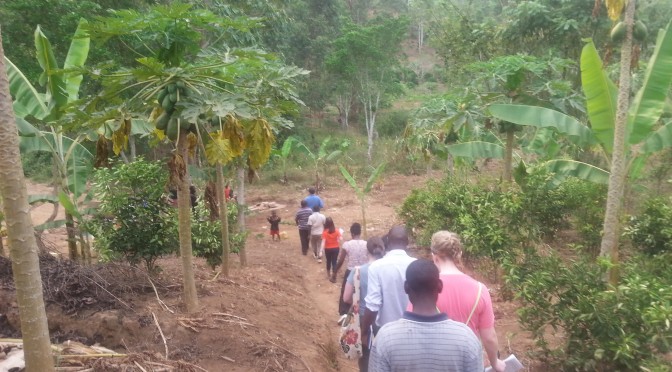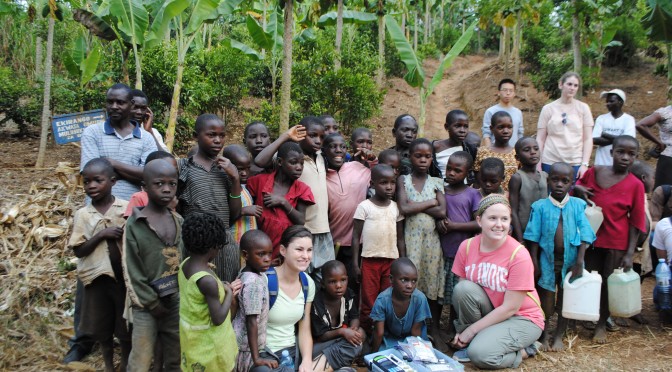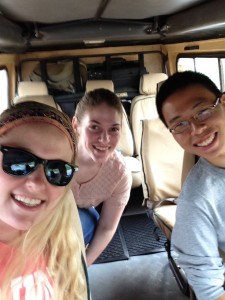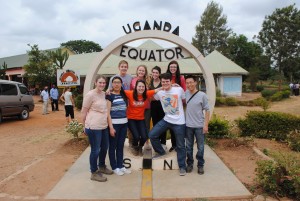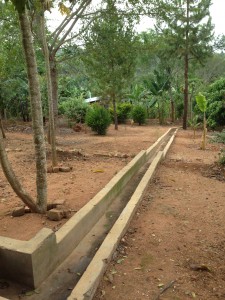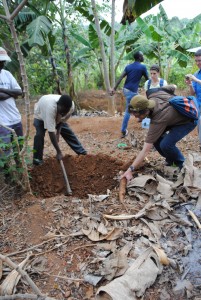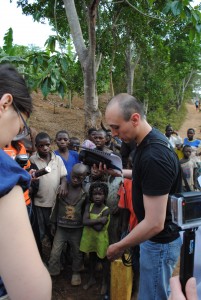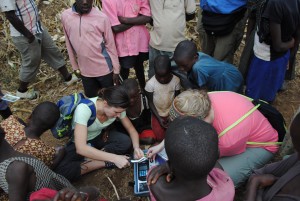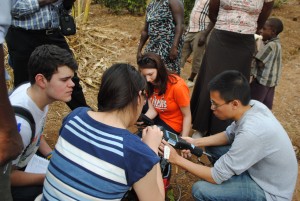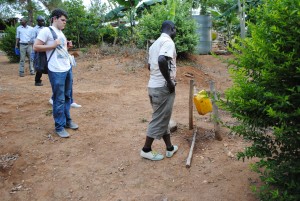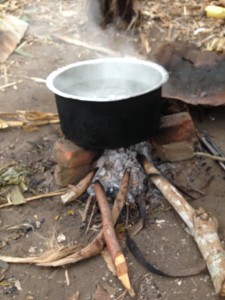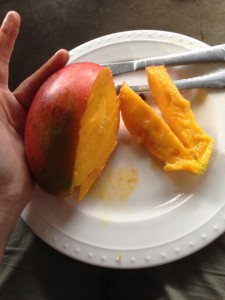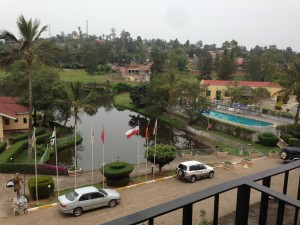Category Archives: Uganda Travel Blog
Day 5, 6 Uganda – Weather station installation (Andrea)
Wednesday February 19, 2015 and Thursday February 20, 2015
What new challenges could rural Uganda possibly have for a weather station that has been deployed in deserts and on glaciers? We would soon find out.
The Safe Global Water Institute (SGWI) added a renewable energy focus this year. We know it is sunny in Africa, but how sunny? There is wind, but how strong? The data we were looking for was not readily available. The lack of research and the desire for specific site information lead us to purchase a weather station for site evaluation. The weather station will be used to measure the solar and wind energy potential starting in the Oruchinga UN HCR refugee settlement. Oruchinga is in the Kalagera river valley in rural south-western Uganda. In one or two years, when the river valley data collection is complete, we hope to relocate the station to Omurutoma, a nearby hill top village.
It took two weeks to pick out the weather station components. When the equipment arrived in Urbana, again, it took two weeks for a test build, to make hardware adjustments, and check software settings. We assembled the weather station on site in less than a day.
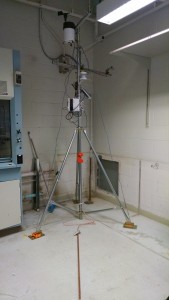
There were last minutes challenges during the test build on campus, of course: a software incompatibility, a last minute sensor mounting change, and finally a last minute weather station data logger case modification. The data logger was picked up from the machine shop at 9 AM. We departed for Uganda via O’hare at 10 AM. Plenty of time.
Traveling with a three meter tripod, even folded and separated in half, is a sight and a little cumbersome. Reggie took on the tripod box as his travel companion for the week. Here he is carrying it at the Entebbe airport.
Did I mention, a site had not been picked out before we arrived? We knew we wanted it in a guarded area, which was about it. The Commandant walked us around base camp, a fenced space with governmental and aid offices, showing us options. The location selected was the flattest protected location with no trees and where both horizons were visible. Downside one, it was next to the garbage pit. Solution, two Ugandan men (referred to as National’s when near a refugee settlement) were hired to dig a new pit away from the selected weather station site and fill in the old pit. Downside two, the ground was covered with burrs and brambles. I was covered after tromping through them to survey the area. Jeremy Guest, one of the two Illinois professors on the trip, found a path. The same men also cleared out the brush in the installation area. Surprisingly, the site preparation was complete by lunch the next day.
Cement, sand, and gravel are best purchased (or found) in country. The renewable energy team, Ellyn, Madeline, Tim and myself, visited the Mbarara town center to get supplies first thing the morning. Moses and Jimmy, two of the guides, took us to get cement, a ladder, and WD-40. After some walking and asking directions every block, we finally found a ladder, the hardest item to get our list. Apparently, most people in Uganda make their own ladders out of trees.
This was the most urban walking around we did. It was not possible, but would have been nice, to take pictures. The town center was bustling at 8 AM. There were women walking through the streets selling food and drinks. Some had canteens of hot drinks. Others, selling food, had stacks of prepared plates, each covered with a bowl stacked, one on top of each other, and placed in a plastic sack. The women would serve the food and drink, waiting nearby to collect the dishes when the customer finished. There were men, motorbikes, and cars everywhere in the roundabout and streets. The area was a maze of streets and alleys.
The weather station crew started work after lunch. The installation team was joined by our guide Moses, a couple hired Ugandan nationals, and plenty of refugee and national onlookers.
Step 1: Assemble Tripod and select placement
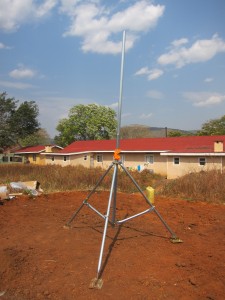
Step 2: Concrete tripod in place
This “simple” step involved two men, then four men used hoes to excavate holes for the concrete footings. They were so enthusiastic; it was difficult to stop them once they’d started. One of the holes ended up significantly larger and deeper than intended. The Ugandans made cutting into the hard clay soil look easy.

Then it was time to mix concrete. The concrete mixing did not start smoothly; it started with us saying “wait” and “stop” a lot. The aggregate for the concrete was too big. The hired men wanted to mix the concrete and didn’t want to listen to our suggested ratios. Then Tim stepped in, taking the lead. He made them remove some of the aggregate, pour the water slowly to better judge the concrete viscosity, and the first layer of concrete was poured. The tripod legs were set up and leveled. Concrete with only sand was poured on top of that. A little creativity and the surface ended up being somewhat smooth.

Check out Madeline’s signature on her tripod foot.
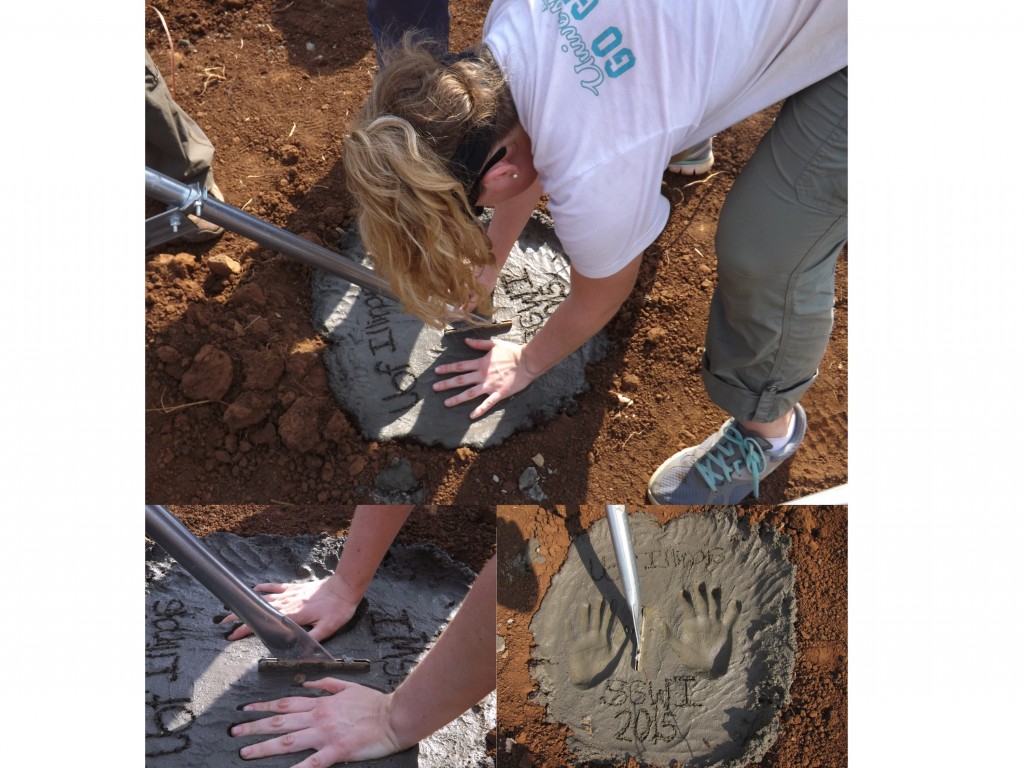
Step 3: Grounding rod
First our guide Moses used a mallet to drive a 4 ft copper grounding rod into the soil. Did I mention the clay soil was hard? The ground is so hard, the mallet handle split while hammering the rod. Moses switched to using the side of an axe head for the last foot. All of the handles and wood used in Uganda appeared to be local. They sold hammers, axes, mallet heads without a handle in the hardware store.
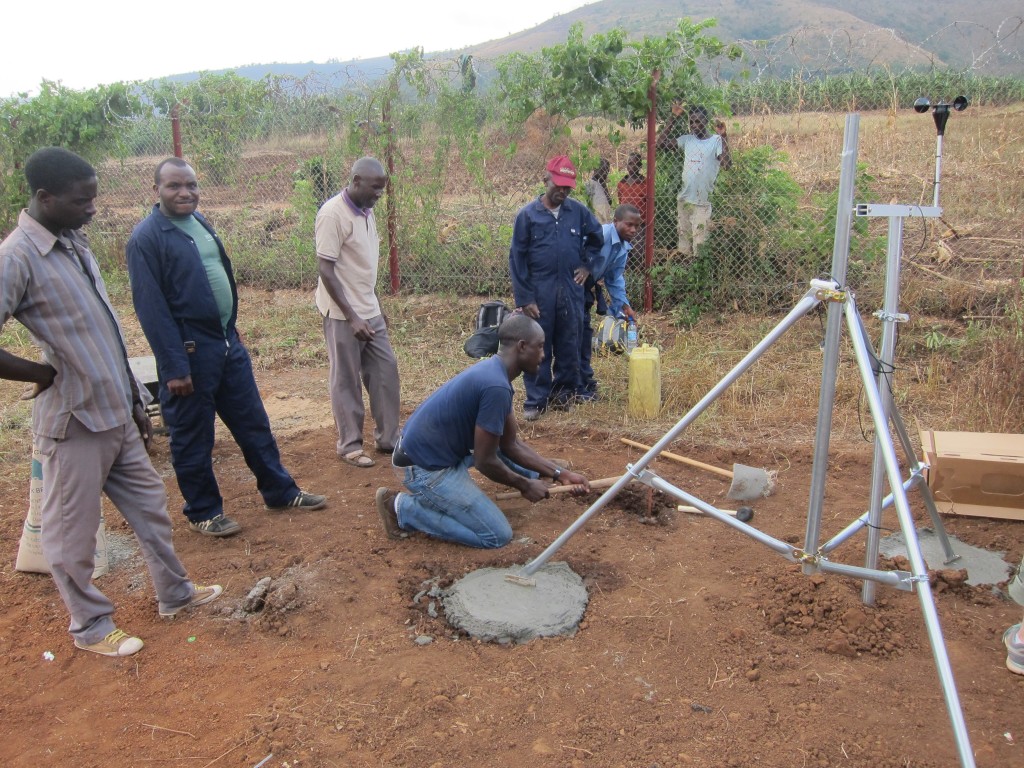
The team took a break around 4 PM, initiated by Ellyn. She showed the children, who were watching us through the fence, how to play with the packaging bubble wrap. None of these children attend school as the primary and secondary schools across the street from the base camp were still in session for the day.

Step 4: Install sensors on upper mast mount
We started installing the sensors the first build day. We got the wind speed and wind direction sensor mounted. As well as the rain gauge, pyranometer (measures solar radiation), and ultraviolet (UV) radiation sensor.
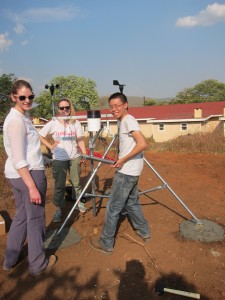
We ended up leaving the weather station incomplete and not securely fastened overnight. Peter Luswata had a surprise cultural experience for the group, a traditional Ugandan dinner and dance show at Igongo Cultural Centre.
The next day, everyone got up early. Oops, we forgot to tell the drivers. Once they grabbed breakfast we got going, only an hour late, to the Oruchinga Refugee Settlement. The rest of the Illinois contingent left for the weekly market in Isingiro town. The renewable energy team + Moses started back on the weather station. I was nervous about if the weather station would be as we left it the night before. It was fine.
Step 4 Continued: Install sensors on upper mast mount
Time for more sensor installation. Working on the weather station definitely drew a crowd. They dispersed some once the upper mast up was put in place.
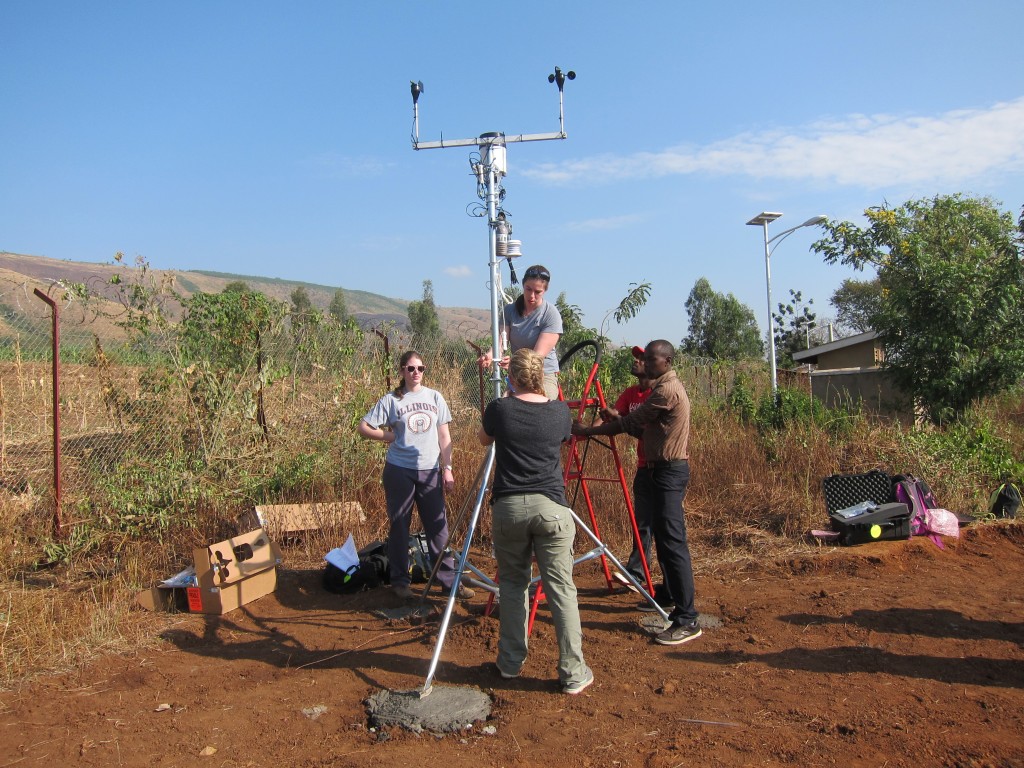
We added the remaining sensors: temperature, relative humidity, and barometric pressure. The heart of the weather station, a data logger and small solar panel to recharge the data logger battery, were added last.
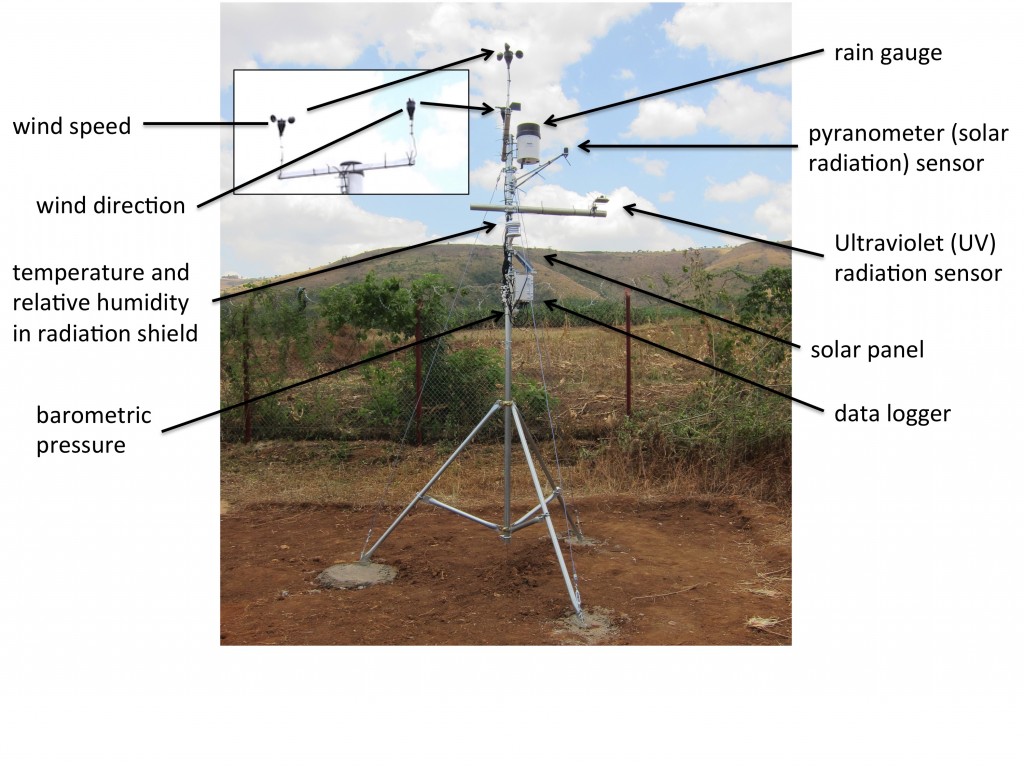 Step 5: Guy wires
Step 5: Guy wires
To keep the tripod stable in high winds, guy wires were installed for the wind sensors (speed and direction). After three tries, we got the right length wires and the tripod pole was level.
Step 6: Wire management and connections
I went a little zip tie crazy. These wires are not going anywhere.
Step 7: Software and hardware communication
It was really bright out. Ellyn ended up acting as shade while I configured the software to record the installed sensors.
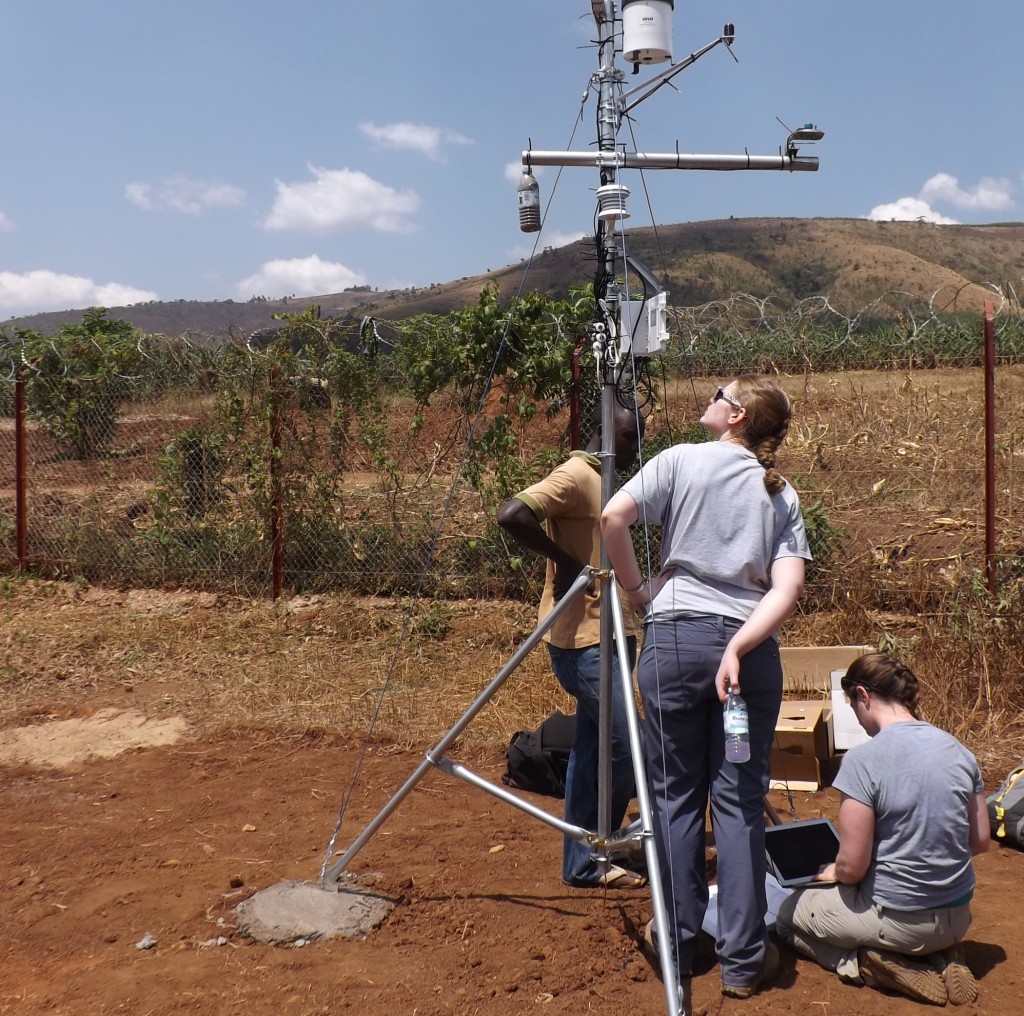
One final check to make sure everything is tight; weather station operational. We were only able to get a couple data point before we had to leave. I’m excited for a couple months from now when we get the first series of weather data thanks to Richard from the Red Cross and, of course, Peter Luswata.
This is one of a few, possibly only the second, weather station in Uganda. As of this moment, it is installed and operational. There were many times I thought it would not happen. Still, I do not know if it will be operational or even standing the next time it gets checked on by the Uganda Rural Community Support Foundation or the SGWI. Getting it installed is a great accomplishment.
Now, I am keeping my fingers crossed and hoping for data.
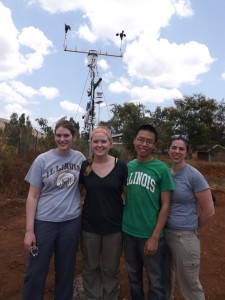
Ellyn, Madeline, Tim, and Andrea
– Andrea Vozar
Day 6 Uganda – Isingiro Town Market and Omurutoma (David)
2/19/15
We started the day before the sun was up, ate a quick breakfast and drove straight to the base camp. The energy team went off to put the finishing touches on the weather station and the other teams began interrogating our trusty comrade, Dhiblawe (a HIJRA, Humanitarian Initiative Just Relief Aid, worker, who has been at the settlement for over a year), to get detailed info regarding the many water sources in the area.

At the weekly market, which is the main source of income for nationals and refugees in the area, we marched up a crowded alley and out into the main trading area where booths and paths carved up the hillside. Like good environmental engineers, we went straight to the latrines to take pictures and check conditions, which must have seemed very odd to the vendors who were setting up for the day. There are four ventilated pit latrines serving a market that sees thousands of shoppers in a day. At a cost of 200 shillings per use, for upkeep, soap and water, the latrines were simple. They did seem that they would meet the most basic sanitation needs of the market, providing the wait or cost were not prohibitive.
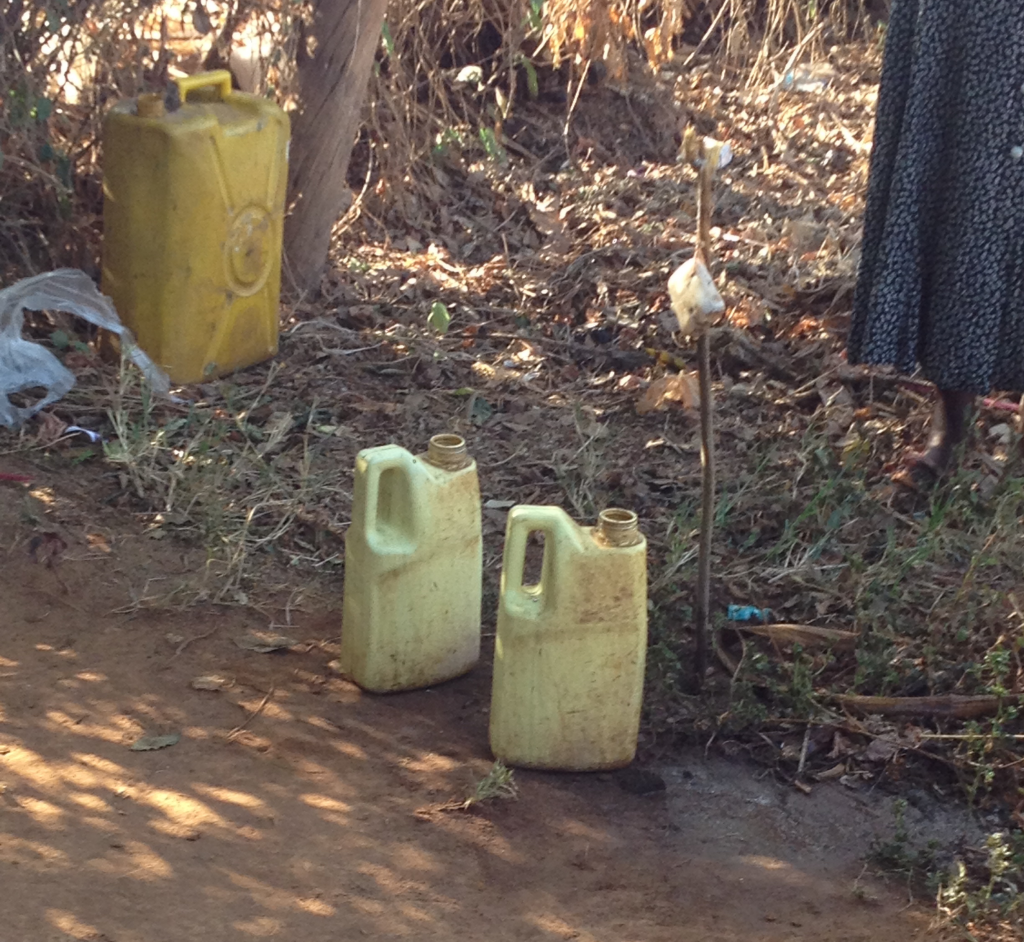
Continuing around the market, much to the interest of the locals, we stopped by the animal and solid waste disposal sites. The carcass-cleaning site, while a bit jarring at first, was well managed, and seemed to be sanitary. Any carcass created at this site was inspected for diseases prior to it’s sale at the market. The solids-disposal site, in the opposite corner of the market wasn’t safe or sustainable. The wastes, compostable and not, were piled six to seven feet high and had already started spilling into useful market space. After the main market, we trekked across the road into a smaller market where homes became shops for the day, blending into the refugee settlement.
Three stops, a natural spring, two health centers, and a hectic car ride running time-sensitive analyses later, we’d lost two of our fearless leaders, Jeremy and Lauren, who were off to Entebbe for their flights home. At this point all of our work at the refugee settlement was done, and we went back to base camp to another delicious lunch prepared for us and our partners. Full and refreshed, we drove up to the top of the mountain to follow up with the Omurutoma community, which had we met on Tuesday. I don’t need to talk here about the drives or the view, but this country is gorgeous. See some photo evidence below:
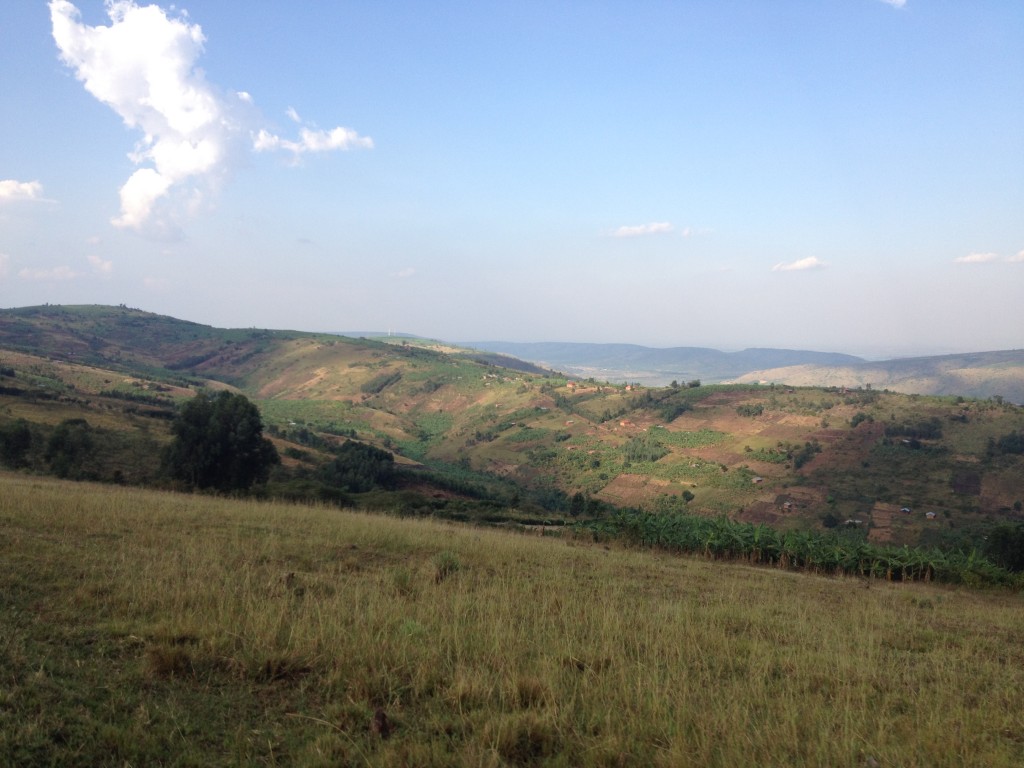
As you can tell from these photos, this area is remote. These people live a three hours walk away from the valley floor where water can be collected, to be carried back up. We split into groups, and between all of us we were able to visit seven different households, collecting water samples from several. The prevailing issue in this community is the lack of access to water. As beautiful as the landscape is, it is also the reason for much of the hardships these people have. Certain members of the community have a hard time making the three-hour trek to the valley floor and cannot pay for water to be brought to them. Not only is the trip demanding, but especially dangerous for women, who are prone to sexual violence and most often the ones collecting the water. Everyone in the community could benefit from the time, safety, and health an improved water source would provide. This was a recurring theme among the households we visited today; where water access was an issue, other issues became secondary.
It shouldn’t go without mentioning the warm welcome we received by all of the people we have interviewed. We have been invited to photograph and document very personal aspects of their lives and this has allowed us to better understand the issues faced by this community. The hospitality and graciousness of the people here have helped us make the most of this incredible opportunity. With our interviews done, we headed back to the hotel to make sense of the past two day’s samples.
Day 6 Uganda – Life is beautiful, the world is beautiful (Liying)
Before I stepped on the land of Africa I had greatly prepared in my mind what it would be like. However, the numerical values for birth rates, death rates, HIV-AIDS, and people with water access are not as striking to you as what you actually see here.
We did house surveys. When we asked them, “Are there any problems with your drinking water?” they answered mostly “no”. Nevertheless, there were problems apparent in the water such as a red color and solids settling. Sometimes they are suffering from the unsafe water, but they have not realized that is the cause.
Water quality is not the only problem. In a village located on the top of the mountain, women and children need to walk 7 hours twice a day to fetch water. During this time they are prone to sexual assaults. Many of the children also have potbellies, which is linked to malnutrition. I can see the significance of being able to affordably provide safe drinking water to everyone in the world.
Through chatting with local friends, I know that men in villages often have three or four wives and each wife gives birth to about seven kids. There are many more females than males; the ratio can be 7 males to 20 females. The marriage model of one husband and one wife, which we have already taken as granted, seems kind of weird here. If girls are raped, resulting in pregnancy, their family normally will not choose to report to the police. If the police take away that man, there will be no one responsible for the girl. Finally, victims choose to marry the criminals for a more secure life.
Multiple wives mean high birthrate. Meanwhile, poor medical condition determines the high death rate. Therefore parents are willing to bear more children, in hopes that more survive. It is a vicious cycle, bringing down the family living standard. Education and medical care are more difficult to access. In my opinion, if this country wants to take off, they must get rid of this cycle first.
When we took water samples in the refugee camp, lots of kids surrounded me. They are so lovely. They held my hands all the way along. I repeatedly told them “You are beautiful; life is beautiful; the world is beautiful; future is beautiful”. I hope they can understand. I told them to study very hard, read lots of books and travel to many countries. I hope they can be happy every day and have a better life. Their life should not be like this.
These days wherever we go, everyone greets to us with big smiles and warm waving hands. I have never been welcomed in this way before and have never been so expected before. I know that how much they expect us is how much the responsibility weighs on our sholders. The origin of pains is not just from environmental factors, since there are too many factors involved—wars, large population, lack of medication, lack of education, politics, and cultural tradition. Maybe what we do is not the key way to wipe out poverty, but I believe the more efforts we put in, the less pains will be in their lives.
I suffered from dental fluorosis myself due to high fluoride drinking water I had in my childhood. I know deeply that some type of harm from bad environmental quality to children will bring them lifelong sufferings. I do not know what the best I can do for them now is, I just hope that through our exploration and efforts, each child can have access to clean water and a bright childhood. I want to avoid pity in their lives, and have them believe life is beautiful and the world is beautiful.
Liying Guo
2/19/2015
Day 5 Uganda – (Hannah)
February 19, 2015
Our day commenced with a “20 minute” car ride to the Millennium Village. Even though the car ride ended up being about 2 hours, seeing the Millennium Village was definitely worth it. The Millennium village is a governmental model of the Millennium Development Goals developed by the United Nations (described below).
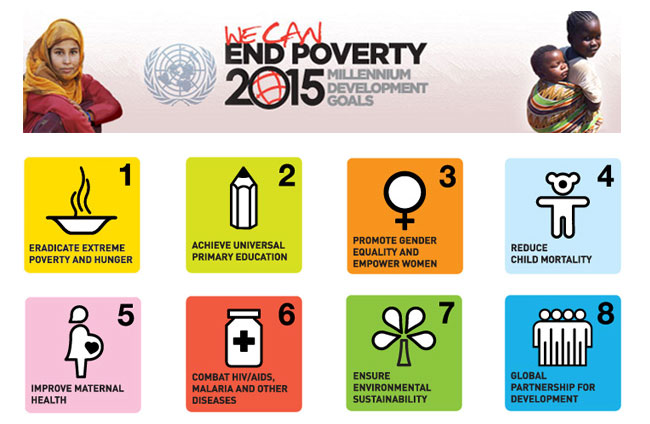
We next went to the local health center in which we learned about the progress that has currently been made in the village. According to the nurse we spoke to, gastrointestinal issues have decreased due to the presence of piped water. Malaria patients have also decreased with the distribution of mosquito nets. It’s amazing that this nurse is seeing progress with these methods of disease and illness protection, but also recognizing that many gastrointestinal issues stem from contaminated waters.
Nearby was the Ruhira Water Supply for the Millennium Water Project.
Before this project, the nearest water supply was over five kilometers away. Now, those within 50 meters of the facility can gain access to the tap for a price that is very affordable. The cost of access to the water supply is 250 Shillings + 1500 Shillings if more than 50 meters from the supply point. The cost of one water unit (1m3?) is 3500 Shillings or 3700 Shillings if the tap is greater than 50 meters from the supply tower. (2800 Shillings to 1 USD.) Though they are not currently treating the spring source water, there is discussion of adding treatment processes. This project gave me hope that a centralized water facility is a possibility in rural communities. I have been researching a lot about using disinfection in point of use versus community systems. Thus far, I had seen a lot of issues with using chlorine in a community system, due to the high possibility of user errors. This project made me rethink ruling out a community disinfection system in the settlement camp.
Next, we arrived at the Oruchinga Refuge base camp for lunch, and then went to the refuge settlement to speak with the community.
1st house: Madame Console
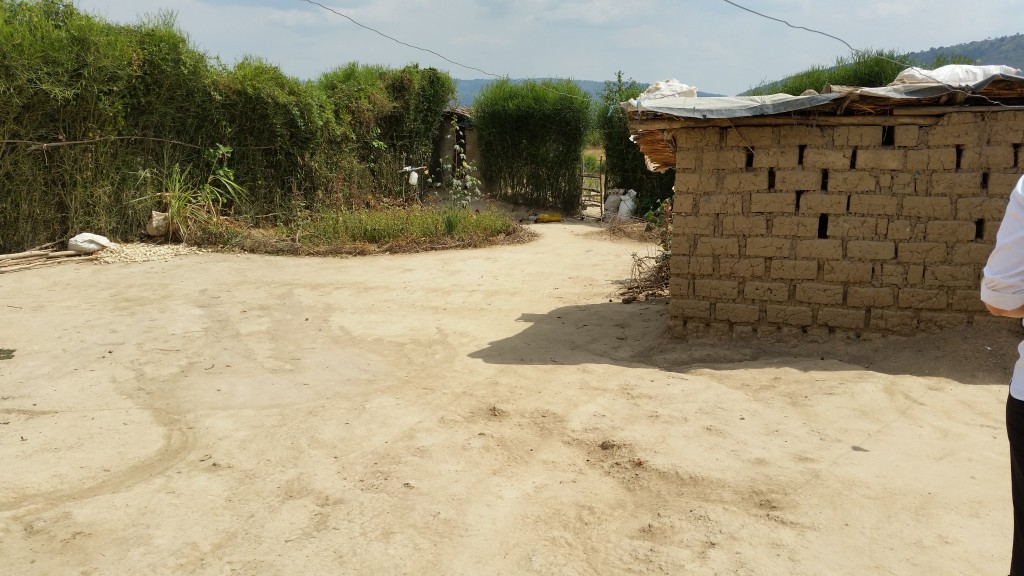
2nd house: Nyonito Household
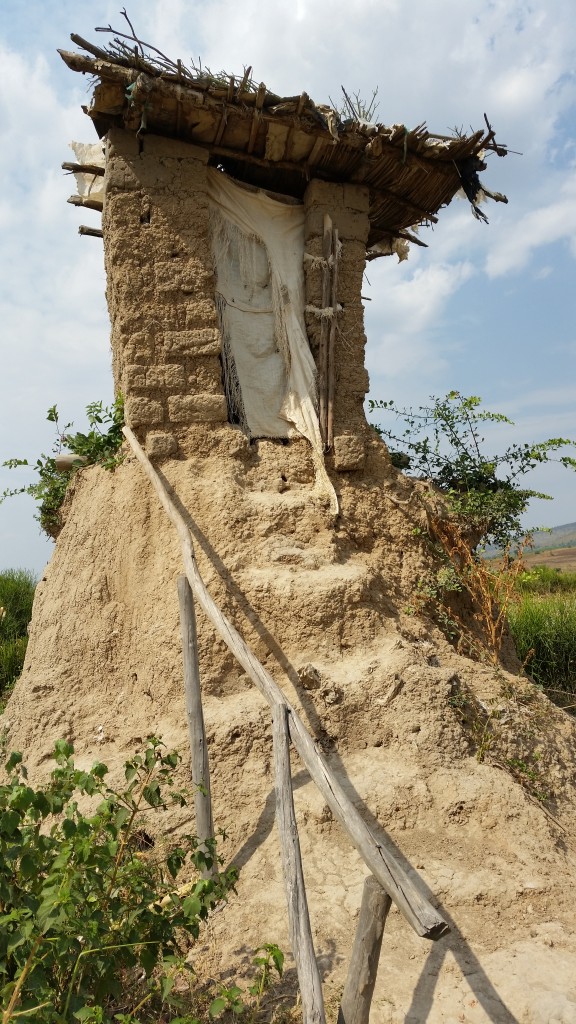
3rd house: Mahoro Household
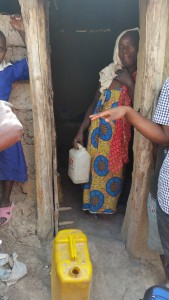
4th house: Odia Household
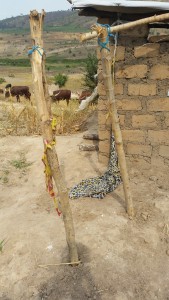
This experience was very similar to my mental image of Uganda before I arrived. I wasn’t expecting an extravagant welcoming ceremony like we received on Tuesday, but a village that was more wary of our presence and motives. As we were about to leave the 2nd house, Nyonito asked us what benefit the research would have on him and the settlement. According to him, people like us come talk to them and ask them questions, but nothing ever changes. At the 4th house, the women immediately started speaking to me, saying that she recognized me and that I had been at the settlement before. It seems like “people like us” come and go often, but I know that we definitely have the ability to leave a sustainable mark on this settlement.
Day 5 Uganda – Dust (Ellyn)
Dust. That is THE word to describe today. No matter how hard you try, you cannot get rid of any of the dust. Plus, it probably wasn’t the best idea to wear a white shirt that shows all of the dirt and grime that accumulates throughout the day.
The day began with a beautiful unplanned scenic route through the vast hills of Uganda trying to find the Millennium Village, which is a village funded by the UN in order to be an example for other villages in order to meet the Millennium Development Goals. What was supposed to be less a half an hour drive turned into an almost two hour drive- off-roading with dirt flying everywhere, making it almost impossible to breathe with the windows open, but also just as difficult to breathe with the windows closed due to lack of air flow. Once found, the village itself was innovative with water pumped to individual houses, electricity, and a health clinic. We did not stay in the village very long, since we had other plans and, although an unforgettable adventure to find the village, took a very long time to find. Retracing our steps, we started to head back through the hills with more dust waiting for our return.
We then traveled to the UNHCR Oruchinga Refugee Settlement Base Camp, where most of the operations for the refugee camp happen, for lunch. After lunch almost everyone was going to the refugee settlement camp in order to talk to the people and get an understanding of the needs of the community, except for three students (including me), a TA and a tour guide. We were staying behind to set up a weather station to test for wind, solar, pressure, rain, and other weather measures in the area in order to collect data on what renewable energy resources would be possible for the community. Once up it will be the second weather station in Uganda, so it is definitely an exciting process. The only problem is that since it is measuring weather it has to be in full sun, meaning we would have to be standing under full Ugandan sun for hours trying to piece everything together and make sure it works.
The site we arrive at to put up the weather station is very obscure pit near the back fence of the Base Camp, which apparently used to be the garbage pit a couple of hours ago. We now got to stand in dirt and get even dustier! At least it was in full sun, I guess…
The first thing we had to do in order to put up the station was make sure it would stay stationary and could not be stolen. In order to do this we needed to cement the station in place. As Civil Engineers you would think all of us would know how to mix concrete, but to our dismay we had to wing it and play it by ear for how well our concrete was mixed and just hope for the best. It all worked out in the end, mostly due to the help of some local men and their expertise in how to build things.
I would have to say my favorite part of the weather station build of the day was giving the bubble wrap from the weather station packaging to some of the local kids trying to watch what we were doing. Who doesn’t love bubble wrap? It was glorious to watch their faces light up by popping a plastic bubble.
Unfortunately we were not able to finish the whole weather station set up in one day, since we had to finish early in order to go for a “cultural experience” which was a mystery to everyone. Since we were running late for this experience we were not able to wash up so I was not expecting it to be anything too fancy, but then our caravan pulls up to a really fancy hotel. By this time I realized how covered in dust and dirt I was (especially with a white t-shirt) and this did not help my hygiene self esteem. Other than feeling somewhat out of place in this very nice hotel the cultural experience was fantastic. We had traditional Ugandan food accompanied by traditional Ugandan dancing.
Today was definitely a “cultural experience”.
Ellyn Weimer
Day 4 – Uganda (Lauren M.)
Tuesday, February 17, 2015
After the ceremony at the top of the mountain, we drove down a very steep and rocky dirt road to the location along the Kagera River where water is typically collected by the surrounding communities. As we approached the river, we had a spectacular view of the mountains in the background. Our driver, William, explained to us that the river is the border between Uganda and Tanzania, so those beautiful mountains just past the river belong to the beautiful country of Tanzania. When we arrived at the water source, two children were at the bottom of the hill collecting water in jerry cans to be loaded on their bike and brought back home to their family.
Following a short break to enjoy the scenery and take photos, we began our sampling and testing of the water. While Madeline, Hannah, Stephen and I were testing the water for a number of water quality parameters with the YSI and Horiba probes, Lauren was teaching Abdullah Dhiblawe about how to use the turbidimeter and what exactly it tests for in the water.
After a few minutes of setting up the Horiba probes, I happened to turn around and look at the river. To my great surprise, at some point while we were testing, a herd of five or six cows walked right past us to the riverbank without anyone noticing.
Once we had all of our samples from the river, we headed to the Base Camp for lunch, where the Commander welcomed us to the refugee settlement once again.
After the extremely warm welcome that we received from the village at the top of the mountain, as well as the welcomes that we have received from everywhere else that we have been so far in Uganda, I was not surprised that we were, yet again, being welcomed so graciously to the settlement.
We finished eating and all headed across the street to the secondary school to teach them about health and sanitation through various games and activities. I was surprised by how many students there were at the school. In the classroom, Lauren led activities that showed the school kids how easily bacteria can spread, how you can’t always tell by looking at water that it is contaminated, and the effects that high levels of fluoride in water can have.
After we finished the activities inside, we went outside with the students to play a game that involved dividing into teams, asking the teams questions, and awarding the first team to answer the question correctly with a chance to score a goal on Daniel with a soccer ball. Many of the students near me didn’t know the answers to the questions, but they seemed to be just as excited to see their classmates (try to) score a goal on Daniel as they would have been if they were to have been able to do it themselves.
Bernardo gathered everyone together to take a polaroid photo, after Lauren and Daniel gave the soccer ball to the students. Some of the students must have been very intrigued by Lauren’s braided hair because found it very entertaining to run their fingers down the back of her head.
It completely broke my heart when I was speaking to one of the students, Fiona, and she told me that should would love to be able to study at a university in the United States, but that there is no chance that that would ever happen. While I encouraged her that she should never doubt her abilities to accomplish her dreams, it saddened me greatly knowing that typically, it really is very difficult for students in African countries to further their education in the United States.
Before we could go back to the hotel, we had to take a few samples and test the water at the secondary school borehole, as well as at the borehole at the basecamp. When we got to the borehole at the basecamp, school children were lined up, waiting to fill up their jerry cans to bring home to their families. While we were waiting for the colorimeter tests to finish, we got the chance to talk to the children around the borehole. They all wanted us to take photos of them, but didn’t quite understand that we couldn’t produce a copy of the photo from our digital cameras and phones. As usual, we were sad that we had to leave, but ready to go back to the hotel after a long day of field work.
Day 4 Uganda – Isingiro District (Gabi)
We started our day off early this morning leaving the Lake View Hotel around 8:30 am. Our end location for the day was the refugee settlement, Oruchinga, and in order to get there we drove over a mountain, making various stops on the way. Insert Picture: Mountain Pic on USB A member of Parliament, Honorable Alex, joined us on the trek up the mountain where we stopped first at a health center. We were able to gain incredibly useful information about the availability of medications and vaccinations provided to the community and the efforts of the health center to educate the community. On our next stop we visited a school quickly to talk to the children about water quality. I enjoyed getting to play with one of the young girls at the school who was fascinated by the tape measure I was carrying.
Our third stop,at the top of the mountain, was at the village where Honorable Alex grew up, Omurutoma. The community was incredible and welcomed us with songs and dances by the children and women as well as many speeches about their excitement to get help to clean up their water. Below is a picture with videos to be posted later.
The next three stops will be covered later but overall it was a great day for all of us!
Day 1, 2, 3 Uganda (Reggie)
Saturday – Arrival in Kampala
Around 11 pm, we arrived in Entebbe and greeted our guides Moses and Martin who drove us from the airport to Kampala, the capital. I think I can speak for most of us when I say that I was shocked with the Ugandan highway system consisting of no traffic lights, no stop signs, no crosswalks and plenty of chaos. After an hour drive depicting some of the Kampalan nightlife, we made it safely to the luxurious Golf Course Hotel (the nicest place I’ve ever stayed at), eagerly awaiting the next day.
Sunday – Kampala to Masaka to Peter’s Farm
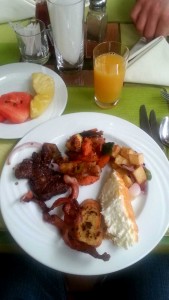
Over the course of the past few weeks, our TA’s and Professors have been warning us about the quality of food we’d see in Uganda. Overall, they described it as repetitive, bland and not filling. Well if Sunday breakfast was supposed to prepare me for the rest of the trip…it didn’t. Fresh cut pineapple and veggies, bacon, steak, eggs, potatoes, toast, passion fruit juice and coffee welcomed all of us in the morning. It set us off on the right foot, but potentially set us up for a huge letdown later on.
We left Kampala around 9 am for Masaka, a town near Peter’s farm. The drive was incredibly beautiful to say the least. Even on a Sunday morning, the streets were packed and the country was bustling. Everyone was out and about, cows were walking down the median, children were running around and businesses were open and active.
Our first pitstop came at the equator. The whole group took plenty of pictures. I took plenty of pictures with my selfie stick and others took plenty of pictures of me taking pictures with my selfie stick. I’m pretty sure no one has looked like more of a tourist than I did during our time at the equator.
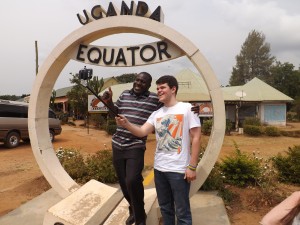
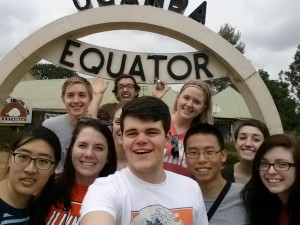
Our second pitstop was for lunch in Masaka Town. We ate at an awesome buffet diner that served a variety of food including Matoke (a roasted banana dish), chicken, beef, potatoes and a peanut sauce that everyone enjoyed. During lunch, some of us made an attempt at learning a few sayings in the local language including “Thank You”, “Good Bye”, “Good Morning Sir” and “Good Morning M’am”. Looking back, I’m fairly sure I spent half of the night saying “Good morning m’am” in place of “thank you”, so hopefully one of the later blogs can track my progress in the language department.
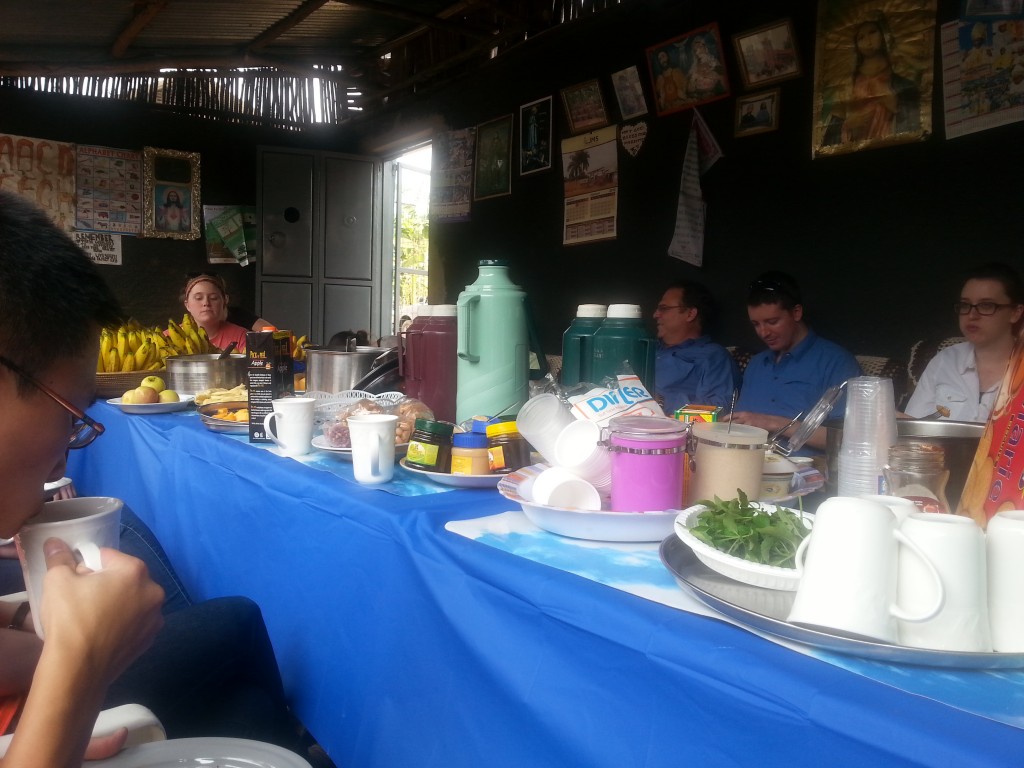
Finally around 3 pm we arrived at Peter’s farm. Our house for the night was appeared small but contained a seemingly endless number of rooms, each with a few beds and our first mosquito nets of the trip. Peter gave us a brief tour of the home, instructing us on how to enter the house (without our shoes), how to go to the bathroom (the latrine off of the kitchen), how to wash our hands (with a small amount of pre-boiled water) and how to take a shower (with a cup and bucket). Before heading out to tour his farm, we enjoyed a “snack” and by “snack” I mean “feast”. We splurged on fresh pineapples, jackfruit, mangoes, peanut butter, chips, pork, and fried cassava (a root vegetable tasting similar to french fries).
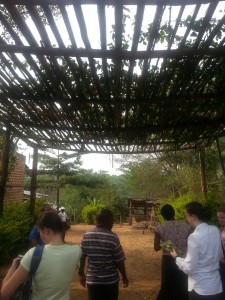
The farm was unbelievable. Used as a model for sustainable farming in an attempt to combat climate change, everything worked in unison and for a purpose. Nothing was wasted. The soil consisted of nutrients from homemade fertilizer and previous plants. Cassava trees frequented the premises whose leaves were eaten by the animals and roots harvested for the people. Pigs and chickens were used for both food, eggs and ranching, with their waste fueling a biogas reactor. On top of all this, the farm has a corn mill, farming training center, multiple well cites, bee farm and grows bananas, plantains and java.
(An aside about Peter. Peter Luswata is a local entrepreneur doing incredible things for all of Uganda. His training center and model farm have helped thousands of local farmers improve yield and learn innovative, proven sustainable farming activities. The work that he does is incredible and under appreciated. I’ve only spent a day with Peter and I know that the world needs more Peters, many more Peters.)
As part of the sanitation team, Kate, David, Lauren and I focused our efforts on Peter’s digester. The underground digester allows the pig waste to break down and produce biogas which is piped up to a gas stove and light. While the digester isn’t nearly as fancy or efficient as the ones in the US, it provides enough energy that could cook meals for a family of five, according to Peter. Peter’s farm has spearheaded the anaerobic digester movement in Eastern Africa and with the help of NGOs and groups like the University of Illinois, he has hopes of it spreading and benefitting farmers throughout the area.
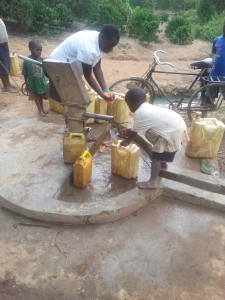
After inquiring about the digester, we took a number of water samples at the local wells. Dozens of children watched as we ran our probes testing for various contaminants. It was truly a cool moment having the local community watch us do our tests in wonder and awe. After witnessing the wells and jerry cans in person, I more than ever want our research to lead to a safer and cleaner drinking water source for these people.
We capped our night with a nice dinner at the house, with items similar to those had earlier in the day (pineapple, potatoes, cassava, pork, matoke and that great peanut sauce). Peter also came around with some fried fish that we had purchased on the road earlier in the day. Before heading to bed, we had a brief group discussion on project options and our plan moving forward when we head to the refugee camp.
Monday – Masaka to Mbarara
Even though Benito let us “sleep in” until 8:30, most of us were up at the crack of dawn due to the local roosters (it produced more of a pig snort sound than a cockadoodledoo). Breakfast once again was extravagant (I don’t think I’ve eaten more fruit ever in my life), however I was unfortunately defeated by a mango (my peeling, slicing and eating produced more mess than actual food). Most of our morning time was spent playing with Prisca, the incredibly cute 2 year old daughter of the homeowners. She was amazed by Lauren’s camera and couldn’t seem to comprehend the video on my phone. I would’ve posted the entire 2 minute video that she took of herself, but the WiFi is limiting (To quote Peter: “How is the WiFi? Not Good? Welcome to Africa”).
We left around ten to Mbarara, a larger Ugandan city about 3 hours from Masaka. The drive was peaceful and scenic, we spotted 3 zebras, 6 impala and 23,189 cows. This part of the country is known for its ranching, opposite of the farming communities we frequented on Sunday.
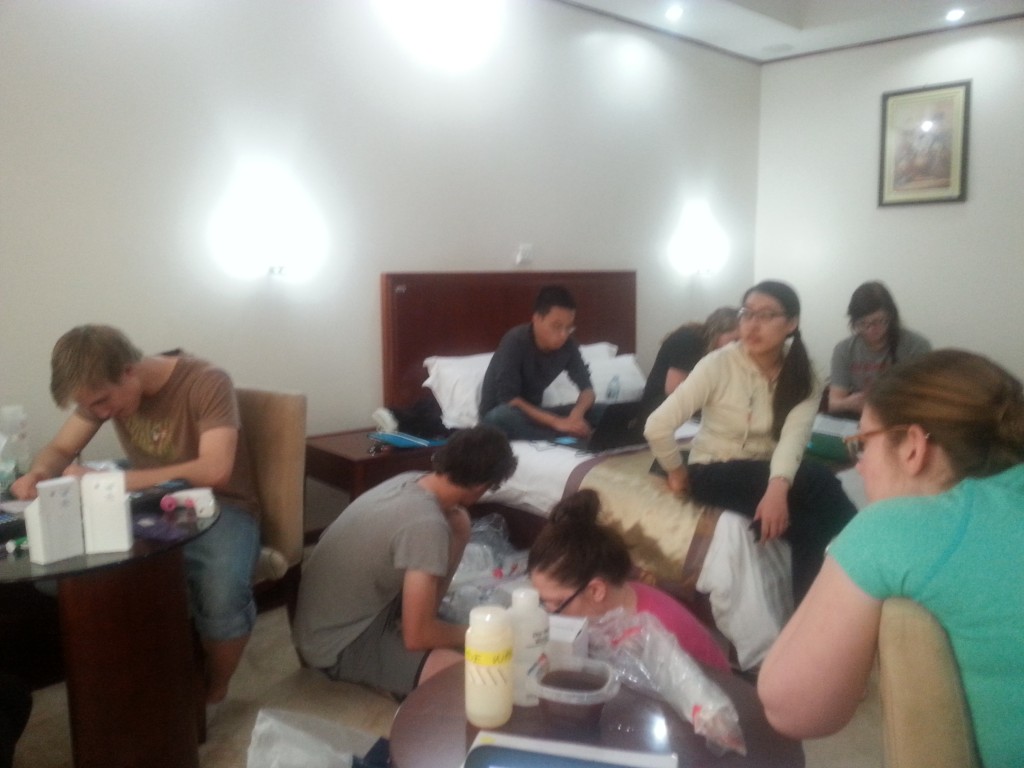
I close my blog with us posted up at the Lake View Hotel in Mbarara. Our team is hard at work calibrating equipment for the next few days at the Oruchinga refugee camp. So far the experience has been incredible and I only expect it to get better, even if the workload ramps up a bit. As someone who has rarely been out of the country, my two days in Uganda have been eye-opening. From using a latrine for the first time to seeing the extreme poverty and low water quality, I’ve not only never been more grateful for everything in my life, but I’ve never been more driven on improving the situation in East Africa. CEE 449 has given us an incredible opportunity and once again I think I speak for all of us when saying that I don’t want to mess it up.
Day 1, 2, 3 Uganda (Madeline)
The renewable energy team on their way to Peter’s farm in the safari vehicle.
First stop, the equator. The student travel team poses for a photo together.
Guided runoff system for pig waste at “Peter’s Farm”, the Rural Uganda Community Support Center. Waste is collected and used for fertilizer.
Digging up Cassava, a local tree. The tree is used for many things such as eating the root, providing lumber, easy to replant using grafts, and can be used to make cement.
Local children swarm the well at Peter’s farm as we start water quality testing.
Lauren, the rural community children, and I testing ammonium and ammonia. The children were so fascinated by us and what we were doing. It was great interacting with the community who we are trying to help.
On site water quality testing.
Tip tap hand washing station. Peter’s farm was very sanitary compared to many other communities we later toured.
All water we used at Peter’s was boiled before use. Did you know the proper way to boil water for drinking is to keep it at rolling boil for 10 minutes?
Peter feed us with so much fresh fruit from his farm while we stayed there. My hands down favorite was the mangos, while we also ate bananas, jack fruit, grapes, and oranges.
Lake View Hotel in M’barara, our home for the next four nights while we are doing work at the Oruchinga Refugee Camp.

